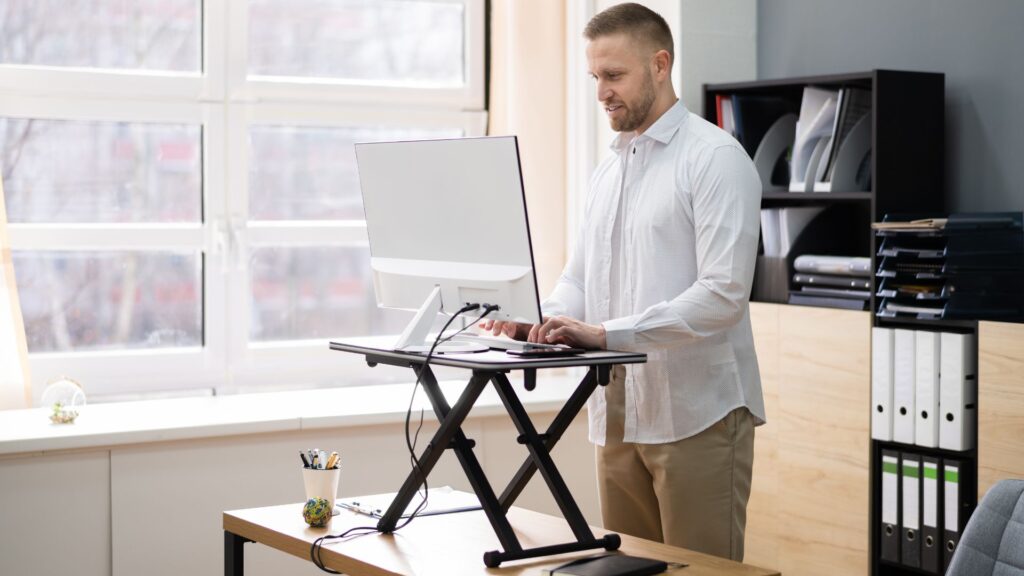Walk into any modern office today and you’ll notice a dramatic shift in how workspaces look. Traditional seated desks have begun to share floor space with their taller cousins. Standing desks have moved from trendy novelty to genuine workplace staple. This transformation happened because people discovered something remarkable about their mental clarity when they stopped sitting all day.
Your posture affects more than just your back. The way you position your body directly influences how well your brain performs. Energy levels fluctuate based on whether you sit or stand. Blood flow changes dramatically with different positions. These physical realities translate into measurable differences in work performance.
This exploration will reveal exactly how standing desks sharpen your mental edge. We’ll examine the science behind improved concentration. You’ll discover practical ways that vertical work positions transform your productivity. Most importantly, you’ll learn whether the benefits of standing desks apply to your specific work situation.
The Science Behind Standing Desks and Focus
Your brain consumes roughly 20% of your body’s total oxygen supply. That hungry organ needs constant fuel to maintain peak performance. When you slump in a chair for hours, your circulation slows to a crawl. Compressed blood vessels struggle to deliver adequate oxygen to your neural networks. The result shows up as afternoon brain fog and decreased mental sharpness.
Standing reverses this physiological problem almost instantly. Your heart pumps more vigorously when you stand upright. Blood vessels open wider to accommodate increased flow. Oxygen-rich blood reaches your brain more efficiently. This enhanced circulation translates directly into improved cognitive function.
Research teams have measured these effects in controlled studies. Workers who alternate between seated and vertical positions show measurably better focus and concentration at work than those who remain seated. Reaction times improve. Memory recall strengthens. Decision quality increases. The connection between posture and mental performance runs deeper than most people realize.
Your muscles play an equally important role in this equation. Standing engages core stabilizers throughout your torso. These constant micro-adjustments keep your nervous system alert and responsive. Your body cannot zone out completely when it actively works to maintain balance. This sustained low-level activation keeps your mind sharp and ready to tackle complex tasks.
Key Benefits of Standing Desks
Better Energy and Alertness
That 3 PM energy crash has become so common that people accept it as inevitable. Your body slides into power-saving mode after lunch. Eyes grow heavy. Thoughts slow to a crawl. Productivity plummets until you can escape for another coffee run.
Standing interrupts this downward spiral before it starts. Your body interprets the vertical position as a signal to remain alert. Metabolic processes continue at higher rates compared to seated rest. You avoid the sedentary stupor that makes afternoon work feel like wading through mud. Mental clarity persists throughout the entire workday rather than fading after lunch.
The fatigue reduction surprises most first-time standing desk users. Many people expect their legs to tire quickly from prolonged vertical positioning. However, the opposite often occurs. Gentle movement and weight shifts prevent the stiff achiness that develops from motionless sitting. You finish work days feeling energized rather than drained.
Improved Productivity at Work
Small movements create surprisingly large improvements in attention span. When you stand, you naturally shift your weight from foot to foot. You stretch occasionally. These brief interruptions reset your focus without derailing your concentration. Your mind stays fresher for longer periods.
Ergonomic office furniture designs recognize this movement principle. The best standing desks for offices include features that encourage gentle activity. Anti-fatigue mats provide cushioned surfaces that reduce joint stress. Adjustable heights let you find your ideal position. Spacious work surfaces accommodate natural reaching and repositioning.
Task completion rates tell the real story. Workers with access to standing options consistently finish projects faster than their seated counterparts. The quality of output improves alongside speed. Fewer errors slip through when your brain operates at full capacity. Creative problem-solving flourishes when mental fog lifts. These productivity gains compound over weeks and months into substantial competitive advantages.
Another Good Read: 10 Home Automation Ideas For Beginners
Workplace Wellness Solutions
Back pain has reached epidemic proportions among office workers. Hours of seated compression wreak havoc on spinal structures. Discs bulge. Muscles weaken. Chronic discomfort becomes the new normal for millions of desk-bound professionals.
Workplace wellness solutions must address this fundamental issue. Standing desks attack the root cause rather than merely treating symptoms. Your spine assumes its natural curves when you stand properly. Pressure distributes evenly across vertebrae. Core muscles strengthen through constant engagement. Pain diminishes or disappears entirely for many users.
Stress reduction represents another powerful advantage. Physical discomfort creates mental tension that sabotages focus. When your body feels good, your mind operates more efficiently. The benefits of standing desks extend beyond mere posture correction into comprehensive wellness improvements. Healthy office habits start with furniture choices that support rather than undermine your body’s natural design.
Standing vs Sitting Desk – Which is Better?
The standing vs sitting desk debate misses the crucial point. Neither option deserves the title of ultimate champion. Your body craves variety rather than static positioning. Extended periods in any single posture create problems eventually.
Sitting offers genuine advantages for certain tasks. Complex analytical work sometimes benefits from the stability of a seated position. Video calls feel more natural when you settle into a chair. Some people find it easier to enter deep focus states while seated. These benefits remain valid and valuable.
Standing excels in different scenarios. Phone calls become more animated and engaging when you can pace slightly. Collaborative sessions flow better with vertical positioning. Energy-intensive tasks benefit from the alertness that standing provides. The benefits of standing desks shine brightest during activities that demand sustained mental sharpness.
The ideal solution combines both options seamlessly. Adjustable desks let you transition between positions multiple times daily. You might stand for morning email processing when energy runs high. Sit for detailed analysis after lunch. Return to vertical positioning for afternoon meetings and calls. This flexible approach delivers advantages from both positions while avoiding the downsides of prolonged immobility.
Dynamic workplaces recognize this balance principle. Forward-thinking offices install height-adjustable furniture as standard equipment. Employees receive guidance on effective position changes. The culture shifts toward movement rather than static seating. Everyone benefits from increased flexibility and choice.
How Standing Desks Improve Focus at Work
- Mental alertness depends heavily on physical state. Your brain cannot operate at peak efficiency when your body feels sluggish and compressed. Standing delivers an immediate boost in circulation that sharpens cognitive function. This effect persists as long as you remain vertical.
- Task performance measurements reveal dramatic differences. Data entry speeds increase by measurable percentages. Error rates drop. Creative output expands. These improvements stem directly from enhanced mental clarity. Your brain simply works better when it receives adequate oxygen and stimulation.
- The best standing desks for offices amplify these effects through thoughtful design. Proper height adjustment ensures your screen sits at eye level. Keyboard placement allows relaxed arm positions. Adequate surface area prevents crowding that forces awkward reaching. Every design element either supports or undermines your ability to maintain focus.
- Sustained attention becomes easier rather than harder at standing workstations. Traditional seated positions gradually become uncomfortable as hours pass. You shift and fidget to find relief. These movements interrupt concentration and break flow states. Standing eliminates this progressive discomfort cycle.
- Environmental awareness increases when you work vertically. You notice colleagues more readily. Spatial orientation improves. This heightened awareness paradoxically enhances rather than disrupts focus. Your brain operates in a more alert state that handles distractions efficiently rather than succumbing to them.
Tips for Using Standing Desks Effectively
Gradual adaptation prevents the soreness that discourages many newcomers. Start with just 20 or 30 minutes of vertical work. Add 10 minutes daily until you reach a comfortable balance. Your body needs time to build the endurance that makes extended standing pleasant rather than painful.
Alternation between seated and vertical positions maximizes the benefits of standing desks while minimizing drawbacks. Set a timer to remind yourself to switch every hour. Some people prefer shorter intervals of 30 to 45 minutes. Experiment to find your personal sweet spot where energy and comfort peak.
Anti-fatigue mats transform the standing experience dramatically. These cushioned surfaces reduce joint stress and encourage subtle movements. Your feet will thank you after several hours of use. Proper footwear matters equally. Supportive shoes with adequate cushioning prevent fatigue far better than dress shoes or high heels.
Desk height requires careful adjustment. Your elbows should bend at roughly 90 degrees when your hands rest on the keyboard. The monitor should sit at or slightly below eye level. Proper ergonomic setup prevents neck and shoulder strain that undermines the wellness benefits you seek.
Wrapping Up…
Standing desks have earned their prominent place in modern offices through measurable performance improvements. The connection between vertical positioning and mental sharpness runs deep into human physiology. Better circulation delivers more oxygen to your brain. Enhanced alertness translates into superior work output. These advantages accumulate over time into substantial productivity gains.
The benefits of standing desks extend far beyond simple posture correction. Energy levels stabilize throughout the day. Focus and concentration at work reach heights that seated positions cannot match. Back pain diminishes or vanishes entirely. Overall wellness improves alongside professional performance.
You deserve furniture that supports your success rather than undermines it. Consider whether your current workspace truly serves your needs. The investment in quality ergonomic office furniture pays dividends through improved health and enhanced productivity. Your body and brain will reward you for making the switch to a more dynamic work position. Take the first step toward better focus today by exploring standing desk options that fit your specific needs and workspace requirements.






1 thought on “Why Standing Desks Improve Focus at Work”
Pingback: What to Avoid When Using an Electric Pressure Washer - Intell Cook